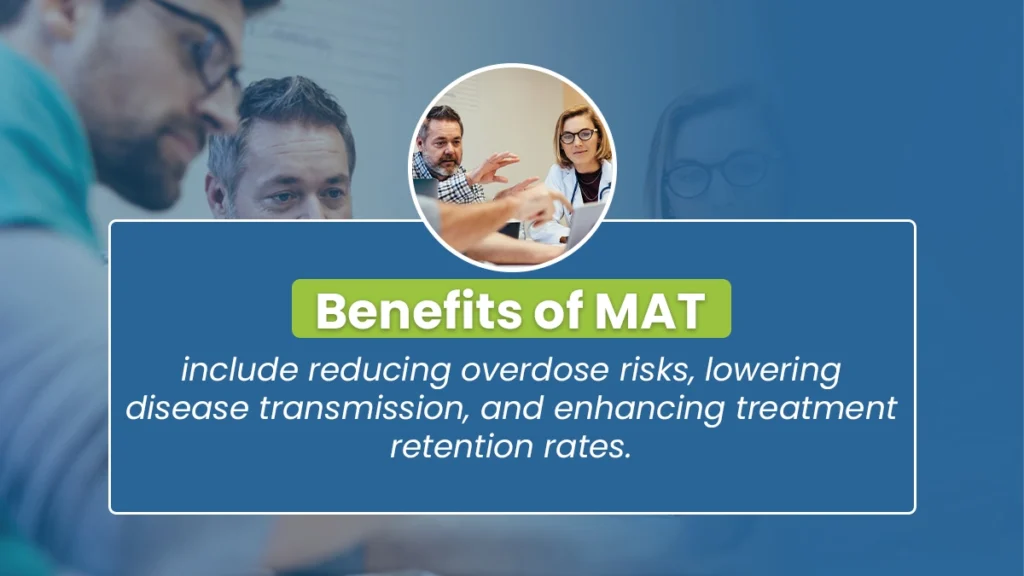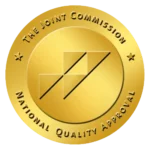Medication-assisted treatment (MAT) is a therapeutic approach utilized to help individuals overcome substance use disorders (SUDs), particularly alcohol and opioid addiction. It combines FDA-approved medications with counseling and behavioral therapies to address the complex nature of addiction.
Let’s dive into the detailed insights of Medication-Assisted Treatment (MAT), its benefits, the medications used, and the individuals who can benefit the most from this approach. By reading further, you will understand how MAT is a pivotal tool in the recovery journey.
Key Takeaways
Medication-assisted treatment (MAT) combines medications with therapy to aid in addiction recovery. Here is what you need to know:
- MAT assists in managing withdrawal, reducing cravings, and supporting long-term recovery from substance abuse issues.
- Benefits of MAT include reducing overdose risks, lowering disease transmission, and enhancing treatment retention rates.
- FDA-approved medications like methadone, buprenorphine, and naltrexone are used in MAT for addiction treatment.
- Opioid and alcohol use disorder patients, dual-diagnosis individuals, pregnant women, and chronic pain patients benefit from MAT.
The Haven Detox-Little Rock offers personalized addiction treatment programs and support. Contact us at (501) 271-3342 for details.
Medication-Assisted Treatment (MAT): An Overview
Medication-assisted treatment (MAT) is a medical approach used to help people recover from addiction. MAT combines medicines with counseling and behavioral therapies to treat substance use disorders (SUDs), like those involving opioids or alcohol. The goal is to manage withdrawal symptoms, reduce cravings, and support recovery.
MAT is commonly used for opioid use disorder (OUD), such as addiction to prescription painkillers or heroin. It uses medications approved by the United States Food and Drug Administration (FDA). These medications, like methadone, buprenorphine, or naltrexone, work differently. Some lessen withdrawal symptoms and cravings, while others block the effects of opioids.
It’s not just about medication. Counseling and therapy are essential parts of MAT. They help address the psychological aspect of addiction, teaching healthy coping skills and preventing relapse. This comprehensive approach increases the chances of successful recovery.
MAT isn’t a one-size-fits-all approach. The choice of medication and treatment plan depends on individual needs and the type of substance use disorder (SUD). It’s often part of a comprehensive addiction treatment plan that includes support from healthcare providers and a strong support network.
Benefits of MAT
Medication-assisted treatment (MAT) offers a spectrum of benefits in combating substance use disorders (SUDs), enhancing the prospects of recovery, and fostering a healthier lifestyle. Let’s explore the various benefits associated with this treatment approach.
Reduction in Overdose Rates
MAT programs significantly contribute to reducing overdose rates among individuals struggling with opioid addiction. By employing medications like methadone or buprenorphine, MAT helps stabilize brain chemistry, curbing the intense cravings and withdrawal symptoms that often result in relapse and fatal overdoses. Through its stabilizing effects, MAT serves as a vital tool in preventing overdoses and saving lives.
Lowering Risks of Contracting Blood-Borne Diseases
One of the notable advantages of MAT is its role in decreasing the risk of contracting blood-borne diseases such as HIV/AIDS and Hepatitis C. By offering safer alternatives to injecting opioids, MAT medications minimize the reliance on high-risk behaviors like needle-sharing, thereby reducing the transmission of these diseases within the population struggling with addiction.
Increase Retention of Treatment
MAT has shown higher retention rates in addiction treatment programs. The use of medications assists individuals in staying engaged in their recovery journey for more extended periods. By alleviating cravings and withdrawal symptoms, MAT fosters a more stable and sustainable path toward recovery, encouraging individuals to remain committed to their treatment plans.
Improve Therapy Outcomes
When combined with counseling and therapy, MAT significantly improves the effectiveness of behavioral interventions. Medications used in MAT help individuals stabilize individuals, allowing them to participate in counseling sessions actively. This contributes to more effective behavioral changes, aiding in developing healthier habits and coping mechanisms.
Better Management of Disorder Symptoms
MAT facilitates the better management of disorder symptoms associated with substance use. By stabilizing brain chemistry and minimizing the physiological effects of withdrawal, these medications enable individuals to focus on their recovery journey. This stabilization is crucial in addressing co-occurring mental health conditions, as untreated substance use can worsen psychiatric symptoms.
These benefits highlight the holistic approach of MAT in supporting individuals on their journey to recovery, emphasizing not only addiction management but also overall health and wellness.

MAT Essentials: Different Medications for Treatment
Medication-assisted treatment (MAT) employs various medications to help individuals in overcoming substance use disorders (SUDs). Three primary medications are commonly used in MAT:
Methadone
Methadone, a long-acting opioid agonist, helps reduce withdrawal symptoms and cravings without producing the euphoric highs associated with other opioids. It functions by attaching to the same receptors in the brain that opioid drugs target, effectively blocking the effects of other opioids while suppressing withdrawal symptoms.
Methadone is usually administered in specialized clinics under strict supervision due to its potential for addiction. Its long duration of action allows for once-daily dosing, providing stability and allowing individuals to function normally without experiencing the highs and lows of opioid use.
Buprenorphine
Buprenorphine is a partial opioid agonist, which means it also binds to opioid receptors but with less intensity compared to full agonists like methadone. It helps reduce cravings and withdrawal symptoms without producing the same level of euphoria or dangerous respiratory depression as other opioids.
Buprenorphine is available in different formulations, including combination medications like buprenorphine/naloxone (Suboxone). The addition of naloxone discourages misuse as it can trigger withdrawal symptoms if the medication is abused by injection. It can be prescribed by specially trained healthcare providers in office-based settings, increasing patient accessibility.
Naltrexone
Naltrexone is an opioid antagonist, meaning it blocks the effects of opioids by binding to the opioid receptors without activating them. Unlike methadone and buprenorphine, naltrexone does not cause physical dependence and has no potential for abuse. It is available in oral form or as a monthly extended-release injection (Vivitrol).
Naltrexone is most effective for individuals who have already gone through the detoxification process and are motivated to maintain abstinence from opioids. However, compliance with naltrexone can be challenging due to the requirement for full detox before initiation and the potential for individuals to discontinue treatment.
Each medication serves a specific purpose, and the choice of medication depends on factors such as the patient’s history, preferences, and treatment goals. When combined with counseling and therapy, MAT provides a comprehensive approach to support individuals on their path to recovery from addiction.
Who Can Benefit From MAT: Understanding the Reach
Medication-assisted treatment (MAT) is a versatile and effective approach that caters to a diverse range of individuals facing substance use challenges. Here’s a breakdown of the groups that can significantly benefit from MAT:
Opioid Use Disorder (OUD)
MAT is particularly effective for those with opioid addiction. It assists in managing withdrawal symptoms, reducing cravings, and promoting long-term recovery. Medications like methadone, buprenorphine, and naltrexone play crucial roles in stabilizing brain function, enabling individuals to regain control over their lives.
Alcohol Use Disorder (AUD)
MAT also proves beneficial for individuals struggling with alcohol addiction. Medications like naltrexone can help reduce the rewarding effects of alcohol, making it an essential component in comprehensive treatment plans. MAT, when combined with counseling, addresses the physical and psychological aspects of alcohol dependence.
Dual Diagnosis
Individuals dealing with both substance use disorders and mental health conditions, known as dual diagnosis or co-occurring disorders, find significant benefits in MAT. This integrated approach addresses both aspects concurrently, providing comprehensive care and improving overall mental and emotional well-being.
Pregnant Women with SUDs
MAT is a valuable option for pregnant women with substance use disorders (SUDs). It helps manage addiction while considering the safety of the unborn child. Carefully selected medications, under medical supervision, can contribute to a healthier pregnancy and better outcomes for both the mother and the baby.
Chronic Pain Patients
MAT extends its benefits to individuals managing chronic pain while navigating the challenges of substance use. Buprenorphine, for example, not only aids in addiction treatment but also serves as an effective pain management tool. This dual benefit makes MAT a viable option for those with chronic pain conditions.
MAT serves as a valuable tool across diverse populations. Its versatility and effectiveness make it essential to today’s addiction treatment options.
Frequently Asked Questions (FAQ)
What is the benefit of MAT?
The benefit of medication-assisted treatment (MAT) is its effectiveness in reducing cravings, managing withdrawal symptoms, and supporting long-term recovery from substance use disorders. It helps individuals regain control of their lives and promotes a safer path to sobriety.
How does MAT work in the brain?
Medication-assisted treatment (MAT) works by stabilizing brain chemistry. It helps reduce cravings and manage withdrawal symptoms, supporting individuals in their recovery from substance use disorders (SUDs).
What are the benefits of addiction medicine services?
Addiction medicine services offer support in overcoming addiction, providing tailored treatments, therapy, and medications. These services assist in managing withdrawal, reducing relapse risks, and promoting a healthier, sober life.
Find Freedom, Embrace Recovery at The Haven Detox-Little Rock
At The Haven Detox-Little Rock, we understand that overcoming substance use disorders (SUD) can be daunting, but our comprehensive programs are designed to guide you toward effective recovery.
Our round-the-clock residential care includes medical detoxification, therapy, medication, and life skills to support your recovery journey.
Our team of medical experts understands that addiction and mental health issues often go hand in hand. That’s why we provide specialized mental health care services that address conditions like depression and anxiety.Don’t wait for tomorrow. Take the first step. Contact us at (501) 271-3342 for more information.





